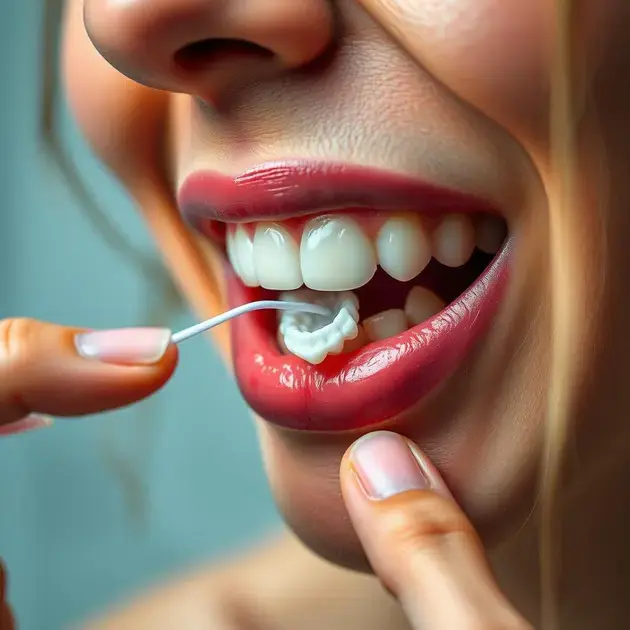Maintaining good oral hygiene is not just about brushing your teeth; flossing plays a crucial role too. Knowing how to properly floss is essential for removing plaque and food particles from between your teeth where a toothbrush can’t reach. Despite its importance, many people still skip flossing because they’re unsure of the correct technique or think it’s too time-consuming.
A recent survey revealed that only 30% of Americans floss daily, which means many are missing out on the benefits of this fundamental aspect of oral care. Flossing helps prevent tooth decay and gum disease by getting rid of the debris that harbors bacteria, thereby promoting a healthier mouth. This guide aims to make the flossing process clear and straightforward, encouraging more people to make it a regular part of their dental routine.

The Importance of Proper Flossing Technique
Proper flossing technique is crucial for maintaining good oral hygiene and preventing dental issues such as cavities and gum disease. One effective technique is the “C-shape” method, where you gently guide the floss in a C shape around each tooth, making sure to go below the gumline. This helps remove plaque and food particles that your toothbrush may not reach. Websites like Colgate.com offer detailed guides on proper flossing techniques, including instructional videos.
Another important aspect of flossing correctly is using the right type of floss for your teeth. Whether you prefer waxed, unwaxed, or tape floss, make sure it glides easily between your teeth without causing discomfort. Oral-B’s website provides information on different types of floss and their benefits, helping you choose the most suitable option for your oral care routine.
Consistency is key when it comes to proper flossing technique. It is recommended to floss at least once a day to effectively remove plaque and debris from between your teeth. Setting reminders on your phone using apps like Google Calendar or setting flossing goals on habit-tracking apps like Habitica can help you establish a routine and make flossing a daily habit.
Regular dental check-ups are essential to assess your flossing technique and make any necessary corrections. Your dentist can provide personalized tips and demonstrations to improve your flossing effectiveness. By following proper flossing techniques consistently, you can maintain a healthy smile and prevent dental problems in the long run.
Step-by-Step Guide to Flossing Correctly
Follow these steps for flossing correctly:
1. Start with a piece of floss around 18 inches long.
2. Hold the floss tightly between your thumbs and forefingers.
3. Gently guide the floss between your teeth using a back-and-forth motion.
4. Curve the floss into a C shape around each tooth and slide it below the gumline.
5. Use a clean section of floss for each tooth to avoid transferring bacteria.
Websites like WebMD provide detailed step-by-step guides with images for flossing correctly, ensuring you cover all areas between your teeth and along the gumline. Following these steps daily will help you maintain optimal oral health and prevent dental issues.
Tips for Making Flossing a Habit
Developing a flossing habit is essential for a healthy oral care routine. One tip is to floss at the same time every day, such as after brushing your teeth before bed, to establish a consistent routine. Using habit-tracking apps like Streaks or HabitBull can help you track your flossing habit and stay motivated.
Make flossing more enjoyable by choosing flavored floss or using floss picks for convenience. Websites like Dentalcare.com offer suggestions for making flossing a more pleasant experience, such as incorporating music or podcasts into your flossing routine.
Reward yourself for sticking to your flossing habit by treating yourself to a special treat or marking your progress on a habit tracker. Positive reinforcement can help reinforce the habit and make it more likely to stick in the long term. With dedication and persistence, flossing can become a natural and effortless part of your daily oral care routine.

Three Common Mistakes When Flossing
When it comes to maintaining good oral hygiene, flossing is an essential step that should not be overlooked. However, many people make common mistakes when flossing that can reduce its effectiveness in cleaning between the teeth and along the gumline.
One common mistake when flossing is not using the proper technique. It’s important to gently guide the floss between each tooth and curve it around the base of the tooth to remove plaque and debris. If the floss is simply snapping up and down between the teeth, it may not be effectively cleaning the areas where bacteria can accumulate.
Another mistake is not flossing all of the teeth. Some people may only floss the front teeth that are easily visible, neglecting the back teeth where food particles can easily get trapped. It’s crucial to floss between every tooth, including the molars at the back of the mouth, to ensure a thorough clean.
Finally, one of the most common mistakes is being too rough while flossing. Aggressive flossing can cause damage to the gums, leading to bleeding and discomfort. Flossing should be done gently but effectively to remove plaque without causing harm to the delicate gum tissue.
The Benefits of Interdental Brushes
Interdental brushes are small, cone-shaped brushes that are designed to clean between the teeth and along the gumline. These brushes can be highly effective in removing plaque and food particles from areas that may be difficult to reach with traditional floss.
One of the key benefits of interdental brushes is their versatility. They come in various sizes to accommodate different tooth spaces, making them suitable for everyone, including those with braces or dental implants. These brushes can easily reach tight spaces between teeth, providing a more comprehensive clean.
Interdental brushes are also reusable, making them a more eco-friendly option compared to single-use floss picks. By rinsing the brush after each use and replacing it when the bristles become worn, they can be a cost-effective and sustainable alternative for daily oral hygiene.
Furthermore, using interdental brushes can help improve gum health by reducing the risk of gum disease. By effectively removing plaque and debris from between the teeth, these brushes can contribute to overall oral health and hygiene.
Alternatives to Traditional Flossing
While traditional flossing remains a popular and effective method for cleaning between the teeth, there are alternative options available for those who may struggle with using floss or prefer different tools.
One alternative to traditional flossing is water flossing. Water flossers use a stream of water to clean between the teeth and along the gumline, making them a gentle yet effective option for removing plaque and debris. These devices can be particularly beneficial for individuals with braces or sensitive gums.
Another alternative is floss picks, which are small plastic tools with a short strand of floss attached. Floss picks can be easier to maneuver than traditional floss, making them a convenient option for on-the-go oral hygiene. However, it’s important to use them properly to ensure a thorough clean.
For those looking for a more natural alternative, wooden plaque removers are available. These soft wooden sticks can be used to gently clean between the teeth and along the gumline, providing a chemical-free option for oral hygiene. They are biodegradable and can be a sustainable choice for eco-conscious individuals.
**
Conclusion
**
In conclusion, maintaining good oral hygiene through flossing is crucial for overall dental health. By avoiding common mistakes such as improper flossing technique, neglecting certain teeth, and being too rough, individuals can effectively clean between their teeth and along the gumline, reducing the risk of plaque buildup and gum disease.
Furthermore, interdental brushes offer a versatile and eco-friendly alternative to traditional floss. These brushes can reach difficult areas, promoting a more thorough clean and improving gum health by removing plaque effectively. Their reusability and suitability for various tooth spaces make them a practical choice for daily oral care.
While traditional flossing remains a popular method, alternatives like water flossers, floss picks, and wooden plaque removers cater to different preferences and needs. Water flossers provide a gentle yet effective cleaning option, especially for individuals with braces or sensitive gums, while floss picks offer convenience for on-the-go use. Wooden plaque removers offer a natural, biodegradable choice for those seeking a sustainable oral hygiene option.
